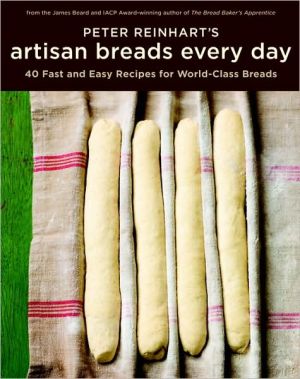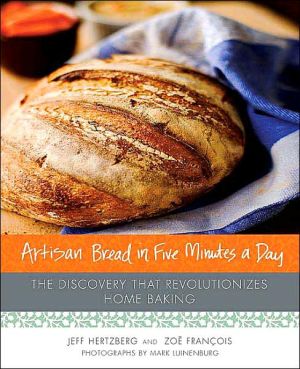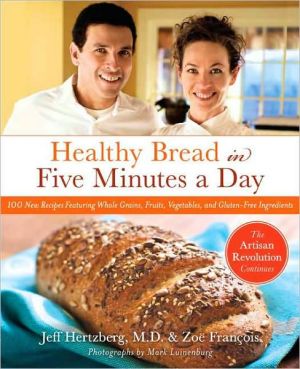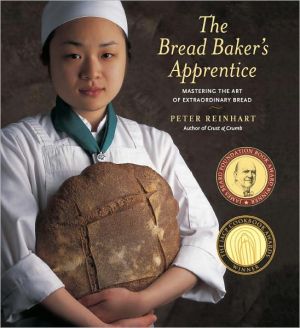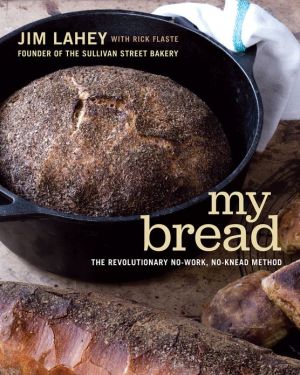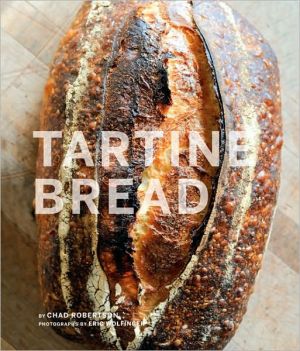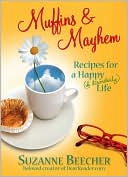Peter Reinhart's Artisan Breads Every Day: Fast and Easy Recipes for World-Class Breads
Peter Reinhart's Artisan Breads Every Day distills the renowned baking instructor' s professional techniques down to the basics, delivering artisan bread recipes that anyone with flour and a fridge can make and bake with ease. \ Reinhart begins with the simplest French bread, then moves on to familiar classics such as ciabatta, pizza dough, and soft sandwich loaves, and concludes with fresh specialty items like pretzels, crackers, croissants, and bagels. Each recipe is broken into "Do Ahead"...
Search in google:
Peter Reinhart's Artisan Breads Every Day distills the renowned baking instructor' s professional techniques down to the basics, delivering artisan bread recipes that anyone with flour and a fridge can make and bake with ease. Reinhart begins with the simplest French bread, then moves on to familiar classics such as ciabatta, pizza dough, and soft sandwich loaves, and concludes with fresh specialty items like pretzels, crackers, croissants, and bagels. Each recipe is broken into "Do Ahead" and "On Baking Day" sections, making every step—from preparation through pulling pans from the oven–a breeze, whether you bought your loaf pan yesterday or decades ago. These doughs are engineered to work flawlessly for busy home bakers: most require only a straightforward mixing and overnight fermentation. The result is reliably superior flavor and texture on par with loaves from world-class artisan bakeries–and all with little hands-on time. America's favorite baking instructor and innovator Peter Reinhart offers new time-saving techniques accompanied by full-color, step-by-step photos throughout so that in no time you'll be producing fresh batches of: Sourdough Baguettes • 50% and 100% Whole Wheat Sandwich Loaves • Soft and Crusty Cheese Bread • English Muffins • Cinnamon Buns • Panettone • Hoagie Rolls • Chocolate Cinnamon Babka • Fruit-Filled Thumbprint Rolls • Danish • Best-Ever Biscuits Best of all, these high-caliber doughs improve with a longer stay in the fridge, so you can mix once, then portion, proof, and bake whenever you feel like enjoying a piping hot treat. Publishers Weekly With “no-knead” bread recipes all the rage now, expert baker Reinhart (Whole Grain Breads) has come back with a process that is slightly more involved but much more productive than the limited classic no-knead method, yielding all manner of sweet, savory and sandwich breads. He introduces a “stretch and fold” technique that, combined with a slow rise and without the lengthy prefermentation that his and other artisan bakers' recipes usually require, means more freedom and less active work time, but still a very flavorful product. To make French baguettes, for example, only one brief knead is required; then, after an overnight or multiday rise, the dough is ready for shaping—much better than being shackled to the kitchen for an entire morning for multiple rises, as is usually the case in baguette making. Other great breads, such as focaccia, soft cheese bread and even panettone, get similar preparation makeovers. Reinhart occasionally calls for a starter, but his carefully constructed, nonintimidating mother starter method should encourage the wary. For bakers who have come to bread through the no-knead route, Reinhart's thorough, detailed recipes offer a perfect way to expand their repertoire without getting their hands too sticky or giving up too much of their time, while those who are already fans will appreciate having a little more room in their schedule while still producing terrific breads. (Nov.)\\
Soft Cheese Bread\ \ MAKES 2 LARGE LOAVES OR MANY ROLLS\ \ You can use any kind of beer in this recipe, as both light and dark brews add subtle flavors that will complement the cheese.\ \ \ 6 1/4 cups (28 oz / 794 g) unbleached bread flour\ \ 2 teaspoons (0.5 oz / 14 g) salt, or 1 tablespoon coarse kosher salt\ \ 5 tablespoons (2.25 oz / 64 g) granulated or brown sugar, or 3 1/2 tablespoons honey or agave nectar\ \ 1 cup (8 oz / 227 g) lukewarm water or beer (about 95°F or 35°C)\ \ 1 cup plus 2 tablespoons (9 oz / 255 g) lukewarm buttermilk or any other milk (about 95°F or 35°C)\ \ 1 1/2 tablespoons (0.5 oz / 14 g) instant yeast\ \ 1/4 cup (2 oz / 56.5 g) melted unsalted butter or vegetable oil\ \ 1 3/4 cups (7 oz / 198 g) diced onion (about 1 medium onion) or 1 small bunch of fresh chives (1 oz / 28.5 g), minced (optional)\ \ 2 1/2 cups (12 oz / 340 g) grated, shredded, or cubed cheese\ \ \ DO AHEAD\ \ In a mixing bowl, whisk the flour, salt, and sugar together (if using honey or agave nectar, dissolve it in the lukewarm water instead). Separately, combine the water and buttermilk, whisk in the yeast until dissolved, then pour the mixture and the melted butter into the dry ingredients. If using a mixer, use the paddle attachment and mix on the lowest speed for 2 minutes. If mixing by hand, use a large spoon and stir for about 2 minutes. Let the dough rest for 5 minutes.\ \ Switch to the dough hook and mix on medium-low speed, or continue mixing by hand, for 3 minutes, adjusting with flour or liquid as needed. The dough should be soft, supple, and tacky but not sticky. Add the onions and mix on the lowest speed or continue mixing by hand for 1 minute, until the onions are evenly distributed.\ \ Transfer the dough to a lightly floured work surface and knead for 1 or 2 minutes to make any final adjustments, then form the dough into a ball.\ \ Place the dough in a clean, lightly oiled bowl, cover the bowl with plastic wrap, and immediately refrigerate overnight or for up to 4 days. (If you plan to bake the dough in batches over different days, you can portion the dough and place it into two or more oiled bowls at this stage.) The dough should double in size in the refrigerator. If you want to bake the bread the same day you mix the dough, don't refrigerate the final dough; just let it rest at room temperature for 60 to 90 minutes, until it doubles in size. Then proceed to shaping and baking as described below.\ \ \ ON BAKING DAY\ \ Remove the dough from the refrigerator about 2 hours before you plan to bake. Transfer the dough to a lightly floured work surface and divide it into 2 equal pieces, each weighing about 2 pounds (907 g). Dust each piece with flour, then use a rolling pin to roll them into rectangles about 8 inches wide and 12 inches high. Spread half of the cheese over the surface of one rectangle and roll the dough up like a rug, from the bottom to the top, to form a log. If any cheese falls out, tuck it back in or save it for the second loaf. Seal the seam with your fingertips. For a sandwich loaf, proof in a greased 4 1/2 by 8-inch loaf pan (or a 5 by 9-inch pan if using onions, which increase the volume of the dough). For a freestanding bâtard or rolls (see page 21), proof on a sheet pan lined with parchment paper or a silicone mat. Another option is to cut the log into 1 1/2-inch slices to make spiral rolls; place spiral rolls about 1 inch apart in greased round pans or on a parchment-lined sheet pan. Mist the shaped dough with spray oil and cover loosely with plastic wrap, then let the dough rise at room temperature for about 90 minutes, until increased to about 1 1/2 times its original size. In loaf pans, the dough should dome about 1 inch above the rim.\ \ About 15 minutes before baking, preheat the oven to 350°F (177°C), or 300°F (149°C) for a convection oven. Because of the cheese, there may be air pockets or tunnels in the risen dough that could cause it to separate in the spirals (cubed cheese creates fewer air pockets than grated or shredded cheese). To minimize this, poke through the top crust in a few spots with a skewer or toothpick. The dough may fall a bit, but it will recover in the oven. \ \ Bake loaves for 20 minutes, then rotate the pans; rotate rolls after 10 minutes. The total baking time is about 50 minutes for loaves, and only 20 to 25 minutes for rolls. The bread is done when it's a deep golden brown and the internal temperature is above 185°F (85°C) in the center.\ \ Remove from the pans and cool on a wire rack for at least 15 minutes for rolls and about 1 hour for loaves before slicing or serving.\ \ \ VARIATIONS\ \ You can substitute potato water (leftover from boiling potatoes) for the water or beer, which will make the dough even softer. The milk provides some tenderness and color, but if you prefer a leaner bread you can replace it with an equal amount of water or potato water.\ \ Feel free to replace some of the bread flour with an equivalent amount (by weight) of whole wheat flour or rye flour. If you do so, increase the amount of water by about 1 tablespoon (0.5 oz / 14 g) for every 7 tablespoons (1 oz / 28.5 g) of whole grain flour you use.\ \ If you would like to avoid the air pockets caused by the melting cheese, you can knead cubed cheese into the dough after the overnight rise, just before shaping, rather than rolling it up in the dough. This will create little cheese bursts throughout the loaf instead of a spiral.
FRENCH BREADS AND SOURDOUGH HEARTH BREADS Lean Bread Classic French Bread Pain à l’Ancienne Rustic Bread Pain à l’Ancienne Focaccia Pain au Levain San Francisco Sourdough Bread Neo-Neopolitan Pizza Dough Sourdough Pizza Dough50% Whole Grain R ustic Bread and Pizza Dough100% Whole Grain Rustic Bread and Pizza Dough BagelsENRICHED BREADS Everyday 100% Whole Wheat Sandwich Bread100% Whole Wheat Hearth Bread100% Whole Wheat Sourdough Hearth Bread Struan Challah Hoagie and Cheesesteak Rolls Many-Seed Bread Soft Sandwich Bread and Rolls Soft Rye Sandwich Bread Wild Rice and Onion Bread Soft Cheese Bread Crusty Cheese Bread English Muffins Soft Pretzels Crispy Rye and Seed Crackers Flaky, Buttery CrackersRICH BREADS Cinnamon Buns Sticky Buns Coffee Crumb Cake Fruit-Filled Thumbprint Rolls Panettone Stollen Greek Christmas or Easter Bread Hot Cross Buns The Best Biscuits Ever Croissants Chocolate Croissants Danish Pastry
\ Publishers WeeklyWith “no-knead” bread recipes all the rage now, expert baker Reinhart (Whole Grain Breads) has come back with a process that is slightly more involved but much more productive than the limited classic no-knead method, yielding all manner of sweet, savory and sandwich breads. He introduces a “stretch and fold” technique that, combined with a slow rise and without the lengthy prefermentation that his and other artisan bakers' recipes usually require, means more freedom and less active work time, but still a very flavorful product. To make French baguettes, for example, only one brief knead is required; then, after an overnight or multiday rise, the dough is ready for shaping—much better than being shackled to the kitchen for an entire morning for multiple rises, as is usually the case in baguette making. Other great breads, such as focaccia, soft cheese bread and even panettone, get similar preparation makeovers. Reinhart occasionally calls for a starter, but his carefully constructed, nonintimidating mother starter method should encourage the wary. For bakers who have come to bread through the no-knead route, Reinhart's thorough, detailed recipes offer a perfect way to expand their repertoire without getting their hands too sticky or giving up too much of their time, while those who are already fans will appreciate having a little more room in their schedule while still producing terrific breads. (Nov.)\\\ \ \ \ \ Library JournalNoted baking instructor Reinhart is the 2008 James Beard Award-winning author of Peter Reinhart's Whole Grain Breads and owner of the Pie Town restaurant (Charlotte, NC). His seventh cookbook offers 50 recipes for bread, bagels, pizza, and pastry. While the accompanying photos are helpful in following the recipes, the lengthy instructions make this cookbook unsuitable for novice bakers. Advanced bakers, however, will enjoy learning Reinhart's time-saving techniques (e.g., starting the recipe the day before).\ \
